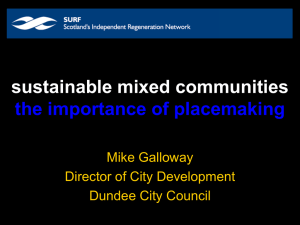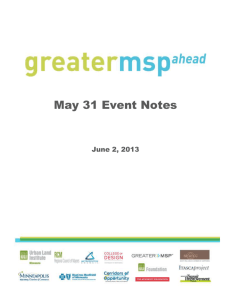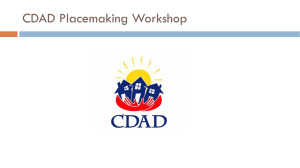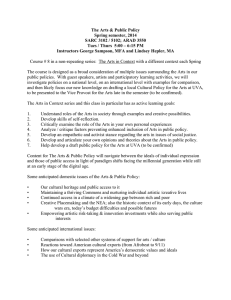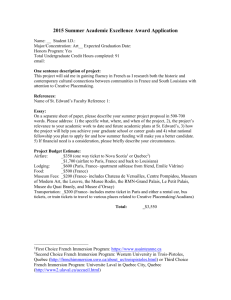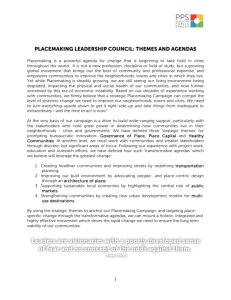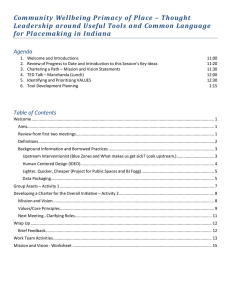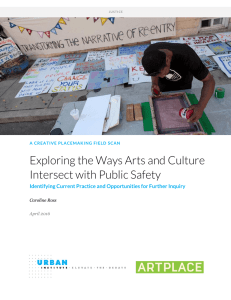I-90 ALLSTON INTERCHANGE A MULTIMODAL TRANSPORTATION PROJECT TASK FORCE MEETING #12
advertisement
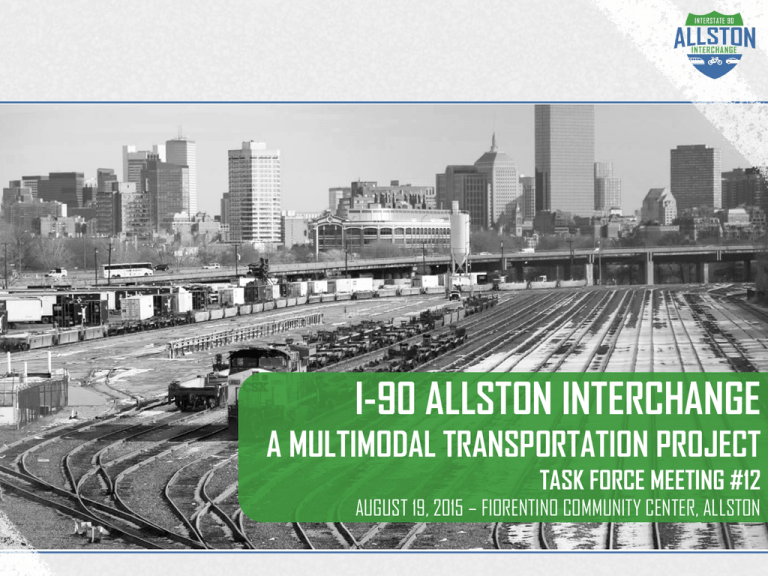
I-90 ALLSTON INTERCHANGE A MULTIMODAL TRANSPORTATION PROJECT TASK FORCE MEETING #12 AUGUST 19, 2015 – FIORENTINO COMMUNITY CENTER, ALLSTON Meeting Agenda • • • • Project Update Placemaking Placemaking Applied to Current Concept Open Discussion of Placemaking Meeting Agenda • Project Update – Harvard University Letter of Intent (Kevin Casey - Associate Vice President, Harvard University, Public Affairs & Communication) Meeting Agenda • Project Update – Harvard University Letter of Intent (Kevin Casey - Associate Vice President, Harvard University, Public Affairs & Communication) – Turnpike At-Grade Alternatives Feasibility Evaluation (Mike O’Dowd – MassDOT) – City of Boston/BRA Place Making Study (Tad Read – Acting Director of Planning, Boston Redevelopment Authority) REQUEST FOR PROPOSAL RFP timeline Issued on Monday, August 17 Bidder’s Conference, August 26, 10:00am, BRA Board Room Proposals due, Wednesday, September 9, 12:00pm Interviews at BRA, Monday, September 14 Recommend consultant, Thursday, September 17, BRA Board Meeting Contract award by October Study complete by March 2016 REQUEST FOR PROPOSAL RFP Scope of Services Major goal will be to ensure that the Preferred Alternative (in its June 2016 form) does not preclude a range of successful urban design, economic development, and neighborhood planning outcomes in the future or limit the discussions which will be part of the Imagine Boston 2030 Citywide Planning Initiative. Subdivided into two (2) Phases Goal will be to have meaningful consulting work completed within two months of initiation of contract; allows for input to be provided to MassDOT in a timely way Available at: http://www.bostonredevelopmentauthority.org/work-with-the-bra/rfps-rfqs-bids REQUEST FOR PROPOSAL RFP Scope of Services PHASE 1 Analysis of existing planning and development context Identification of urban design and planning principles Compatibility of current MassDOT design with planning and placemaking principles and economic opportunities PHASE 2 Creation and testing of alternative build-out scenarios Analysis of multi-modal systems and connections to transit Creation of long term planning framework diagrams PLACEMAKING Working method Fully integrated into the I-90 Allston Interchange Task Force process Complemented by Placemaking Subcommittee which will meet more frequently Collaboration between MassDOT, Harvard, City of Boston/BRA, and community stakeholders Coordination between BRA consultant and MassDOT consultant (CSS) All consultants and stakeholders will operate with the same fundamental guiding placemaking principles CSS has initiated preliminary work; seeking feedback and alignment with principles Meeting Agenda • Project Update • Placemaking Placemaking Definition • Katherine Fichter – Assistant Secretary for Policy Coordination, MassDOT • Tad Read – Acting Director of Planning, Boston Redevelopment Authority Placemaking Definition For the purposes of this Study, “placemaking” is seen as a context-sensitive approach to urban design and planning principles that create a seamless integration of the new with the old. It should maximize the opportunities to extend the best qualities of Boston’s unique urban fabric as a series of wellconnected districts and neighborhoods with a clear hierarchy of walkable, human-scaled streets and blocks into the Study area. Shared Priorities (from earlier meetings) Improve safety for all modes: walking, cycling, driving, transit Realign I-90 Context sensitive design or: Lessen impact of interchange Avoid inducing cut-through traffic with new configuration Reconnect sections of Allston to each other and the River Protect the neighborhood during construction A more vibrant Cambridge Street that serves all modes Accessibility to transit at future West Station Placemaking Principles • New districts and neighborhoods should include a range of densities and land uses which create a distinct destination in the city; they should maximize opportunities for walking and face to face engagement. • To greatest extent possible, streets and blocks should be designed at a human scale, with every attempt to make pedestrians feel safe, comfortable, engaged and visually stimulated. Placemaking Principles (cont.) • Graceful transitions should be encouraged to ensure compatibility in scale and character between higher densities and lower densities. • Access to useable open space for active and passive recreation and cultural activity is a right of all Boston citizens and visitors. Placemaking Principles (cont.) • The City and community should plan for the impacts of climate change and sea-level rise and mitigate its effects through incremental adaptation in infrastructure and the built environment. • Streets and blocks should be designed to provide active and generous street edges that provide safe movement of pedestrians and bicycles while also supporting vehicular movement and transit. Placemaking Principles (cont.) • The Boston Complete Streets Design Guidelines should apply to all streets in Boston under City control, including the neighborhoods and districts within and surrounding the proposed new Allston I-90 Interchange and West Station infrastructure. • New streets should accommodate vehicles in a safe, dependable, and predictable manner, without leading to harmful congestion, which can harm air quality, exacerbate cut-through traffic, and increase stress on cyclists and pedestrians. Meeting Agenda • Project Update • Placemaking • Placemaking Applied to Current Concept Placemaking Applied to Current Concept • Deneen Crosby – CSS • Skip Smallridge – CSS • Etty Padmodipoetro – Urban Idea Lab Framework for Discussion • • • • Base Conditions and Analogs: Current Concept Placemaking Components Site Capacity: Current Concept Next Meeting: Placemaking Concepts Concept Description • Overview of the J concept Neighborhood Pedestrian and Bicycle Connections Key Issues – Slopes and Distances Market Street Beacon Street Street Character – Cambridge Street South Street Character – Cambridge Street South cont. Street Character – Cambridge Street South 2nd Ave., NYC Street Character – Cambridge Street South Brighton Ave. Street Character – Cambridge Street Street Character – Cambridge Street Seaport Boulevard Street Character – Cambridge Street Beacon St., Coolidge Corner Street Character – East Drive Connector Street Character – East Drive Connector Columbus Ave., Boston Street Character – East Drive Connector with Greenway Connection to Esplanade Charles River Esplanade Charles River Esplanade (cont.) Charles River Esplanade (cont.) FLOATING DOCK ON CHARLES RIVER Placemaking + Identity Components • • • • • • • Streets Parks Squares Buildings Plazas Icons Transportation Nodes Streets and Parks Squares Buildings and Plazas Icons Transportation Nodes Pedestrian & Bicycle Bridges The Organizing Principles (1) Build Placemaking into the base design - Highways, Streets, Pedestrian/Bicycle Connections and West Station (2) Maintain flexibility for later phases – for accomodating the building program, parcel access and open space in various configurations and phasing options 46 Key Issues – Slopes and Distances Hotel Hotel & Garage Multi-family Apartment/Condominiums Office Parking Retail/Restaurants Townhouses Minimum Composite Block 2 Multi-Family Buildings Large Parking Garage/Large Office Building Parcel Types and Dimensions Preliminary Project Timeline Next Meeting Nathaniel Curtis, Howard Stein Hudson, Public Involvement (617) 482 – 7080 ext. 236 | ncabral-curtis@hshassoc.com Next Meeting: Mid September | Topic: Highway & Interchange Issues
